
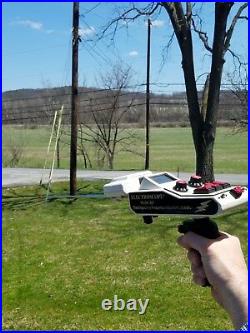
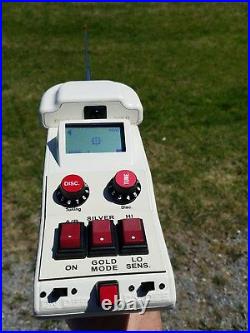
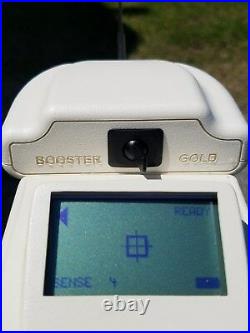
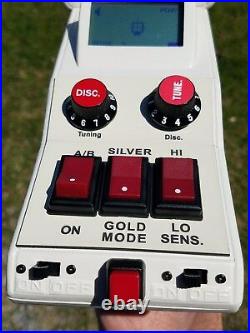

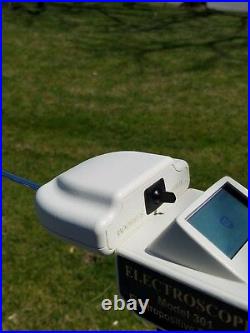
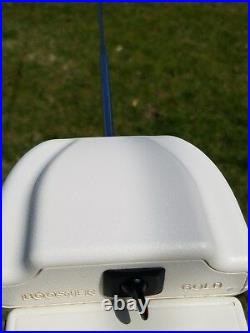
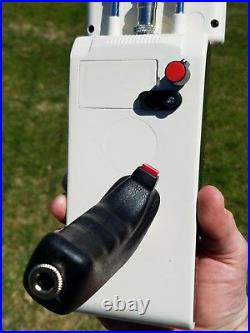
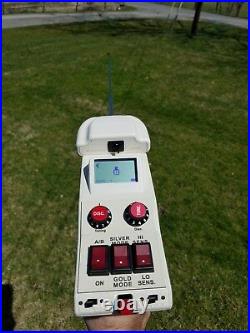

It may be a global economy, but America still makes the best electronics in the world. MODEL 301 DIGITAL – Long range locators are normally used alongside conventional metal detectors. The locators can quickly scan a wide area and determine if a concentration of gold or other valuables are within the reach area of the instrument. If no target is picked up, the operator can eliminate and just ignore the site, and move on to the next position to be scanned. If a target lock is achieved, then the conventional metal detector can be used to quickly search the designated spot in order to pinpoint and recover the target. A target lock is achieved when the 301, which is free floating on its handle, points to a particular area and resistance or a pull is felt when the operator tries to point away from it. Easiest way to mentally picture a target lock is this : if you hold a compass in your hand, the needle will point NORTH. If you change the position of the compass, regardless of how you rotate, the needle will resist the change, and still point to the original North position. The 301 reacts basically the same way. In order to minimize the target area, the operator can take several readings from various positions, taking note of where the visual lines from each position intersect. That will be the general area of target position. Now the operator needs to pinpoint the target center by searching a small area. The 301 is mostly designed to find somewhat large targets, but numerous EXPERIENCED operators are able to locate small targets as well. The 301 is not a conventional metal detector and does not work as one. If you never used long range equipment, you will need to spend some time learning what the instrument is trying to tell you before you become precise with it. If you are not the patient type willing to spend time in the field with it and expect this to be your personal “magic wand”, then this is not for you. Distance and depth of the instrument is largely dependent on size of targets and length of time in the ground. Freshly buried targets or “test targets” sitting above the ground will not generate strong pulls or target locks. Maximum depth on large targets can reach as deep as 20 feet -7 meters. Small targets from below surface to 3 to 6 feet plus – 2 meters deep or more. Please note: New test targets placed in front of the 301 for testing purposes may or may not cause a reaction. Long buried targets, 50 years or more, will cause a STRONG reaction. This is due to the chemical reaction that takes place between the target itself and the minerals in the ground which naturally occurs from years in the soil, amplifying the conductivity/signal response. The longer the target its buried the easier it can be located. The item “TESOROS DE ORO Y PLATA LONG RANGE LOCATOR METAL DETECTOR BROOKLYN NY DEALER” is in sale since Monday, March 25, 2019. This item is in the category “Business & Industrial\Test, Measurement & Inspection\Test Meters & Detectors\Metal Detectors”. The seller is “metdetdist” and is located in Brooklyn, New York. This item can be shipped to North, South, or Latin America, all countries in Europe, all countries in continental Asia, Australia, South africa, New Zealand, Egypt, Reunion.
- Country/Region of Manufacture: United States
- MPN: Does Not Apply
- Brand: METAL DETECTOR DISTRIBUTORS NYC


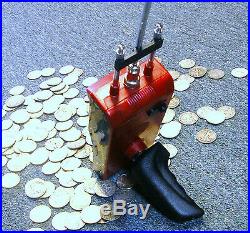
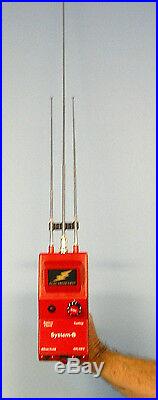
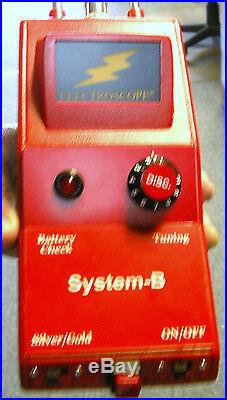
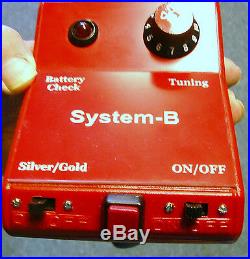
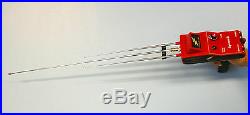
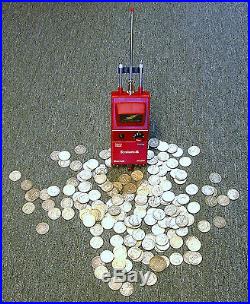
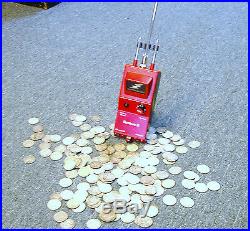

Long range locators are normally used alongside conventional metal detectors. The locators can quickly scan a wide area and determine if a concentration of gold or other valuables are within the reach area of the instrument. If no target is picked up, the operator can just ignore the site, and move on to the next position to be scanned. If a target lock is achieve, then the conventional metal detector can be used to quickly search the designated spot in order to pinpoint and recover the target. A target lock is achieved when the SYSTEM B, which is free floating on its handle, points to a particular area resisting from pointing away from it even when the operator swings past it. Easiest way to mentally picture a target lock is this : if you hold a campass in your hand, the needle will point NORTH. If you change the position of the compass, regardless of how you rotate it, the needle will resist the change, and still point to the original North position. The B reacts basically the same way. In order to minimize the target area, the operator can take several readings from various positions, taking note of where the visual lines from each position intersect. That will be the general area of target position. Now the operator needs to pinpoint the target center by searching a small area. The B is mostly designed to find somewhat large targets, but numerous EXPERIENCED operators are able to locate small targets as well. The B is not a comventional metal detector and does not work as one. If you never used long range equipment, you will need to spend some time learning what the instrument is trying to tell you before you become proficient with it. If you are not the patient type willing to spend time in the field with it and expect this to be your personal “magic wand”, then this is not for you. Distance and depth of the instrument is largely dependent on size of targets and lenght of time in the ground. Freshly buried targets or “test targets” setting above the ground will not generate strong pulls or target locks. LONG BURIED TARGETS will produce a strong signal. This is due to the fact that over time a strong chemical reaction takes place between the metal and the minerals in the ground. Longer a target is buried, the stronger the pull. Small target from surface to 4 feet, distance 100 feet plus. Medium target depth up to 8 feet, distance 250 feet. Large target up to 12-15 feet, distance 1000 feet plus. Keep in mind these are general specs, dependent on various conditions such as: operator ability, ground minerals, dry or wet ground, how long target is buried, type of metal, size of target, interference, and various other factors. BOOSTER NOT VISIBLE IN PICTURES. Occasionally we will make an exception to this, if a valid reason is stated, but only if the item is unopened AND UNUSED. PLEASE NOTE : These do not work like regular metal detectors, as they DO NOT emit sound due to the presence of a target. All targets are denoted by the movement of the instrument. It will take time for a first time user to learn proper procedures, balancing, and target locks. These require a certain amount of time and patience to learn proper operation. The item “TESOROS DE ORO Y PLATA IN MEXICO LONG RANGE METAL DETECTOR DEEP SEARCH 10 METROS” is in sale since Saturday, June 1, 2019. This item is in the category “Business & Industrial\Test, Measurement & Inspection\Test Meters & Detectors\Metal Detectors”. The seller is “sphinxit3″ and is located in PA. This item can be shipped to United States, Canada, United Kingdom, Denmark, Romania, Slovakia, Bulgaria, Czech republic, Finland, Hungary, Latvia, Lithuania, Malta, Estonia, Australia, Greece, Portugal, Cyprus, Slovenia, Japan, China, Sweden, South Korea, Indonesia, Taiwan, South africa, Thailand, Belgium, France, Hong Kong, Ireland, Netherlands, Poland, Spain, Italy, Germany, Austria, Bahamas, Israel, Mexico, New Zealand, Philippines, Singapore, Switzerland, Norway, Saudi arabia, Ukraine, United arab emirates, Qatar, Kuwait, Bahrain, Croatia, Malaysia, Brazil, Chile, Colombia, Costa rica, Panama, Trinidad and tobago, Guatemala, Honduras, Antigua and barbuda, Aruba, Saint lucia, Barbados, Bangladesh, Brunei darussalam, Bolivia, Egypt, Guadeloupe, Iceland, Cambodia, Sri lanka, Oman, Peru, Pakistan, Paraguay, Reunion, Viet nam, Uruguay, Belize, Dominica, Grenada, Saint kitts and nevis, Montserrat, Turks and caicos islands, Bermuda, Ecuador, French guiana, Guernsey, Gibraltar, Jersey, Jordan, Cayman islands, Liechtenstein, Luxembourg, Monaco, Macao, Martinique, Maldives, Nicaragua.
- Country/Region of Manufacture: United States
- Type: Handheld
- MPN: Does Not Apply
- Brand: Electroscopes by Thomas
- Intended Use: General Purpose




















